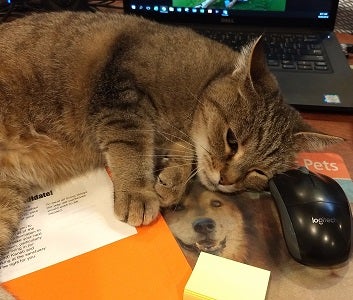
We do what?
Policies, procedures, and the importance of writing them down
If I asked you to show me your policies and procedures, what would I see? Back in the day you might have pulled out a gigantic dusty folder from the corner of an office somewhere. These days they are most likely hidden in someone’s cloud storage and it’s possible that person doesn’t even work for the organization anymore. Or maybe you’ve never even written them down at all. Possibly the task has seemed just too overwhelming or perhaps you are of the mindset that policies and procedures are too restrictive and stifle creativity.
If any of the above scenarios apply to you and your organization, you’re not alone.
Whether you’re feeling overwhelmed at the thought of getting all your policies and procedures in order, or starting from scratch with nothing in place, take a deep breath. We’ve got you!
We work with network partners all the time who don’t have any policies or procedures in writing, or whose procedures were written three directors ago and most of the staff doesn’t even remember where to find them. Is it worth it to put some effort into fixing them up? It absolutely is. These documents are crucial to making sure your staff is consistent with the public and the animals in your care, but also to ensuring what your organization is doing aligns with its goals and philosophies.
So, what do I work on first?
First up, you can’t build procedures without having some basic policies in place. A policy is what you do and why you do it. That’s your starting point. In the best-case scenario, a policy will reflect your organization’s mission or values. Next, use those policies to write your procedures, which explain how you do something.
For example, let’s say you want to write a procedure for outcomes and it’s important to your organization that no animal stays in your care any longer than necessary. A simple policy statement might say “To save as many animal lives as possible (the why), we will eliminate any barriers that keep us from providing each animal the best outcome as rapidly as possible (the what).”
This statement can help you draft numerous procedures, from how to quickly move an animal through your care, to how you process adoptions, transfers or other outcomes.

I know we need some written policies and procedures, but I’m feeling overwhelmed
The first thing to remember is that you’ve operated for some time now without these documents, so don’t panic. The best place to start is to write a few policies and procedures around areas of risk: the risk of someone getting hurt; the risk to your organization’s reputation; or the risk to animals who do not receive appropriate care. Try to work on one or two a week. Keep them short, simple and easy to read with bullet points versus a long narrative. You’ll get them done quicker and your staff will thank you!
Next on your list should be policies and procedures for situations that cause confusion. If you’ve been operating without written procedures, there’s a good chance your team is operating based on who trained them and who trained that trainer.
Years ago, I worked as a kennel attendant, cleaning and feeding based on how I was taught. We fed two times a day. Every Monday, I arrived to see a kennel full of diarrhea. What was happening? After I brought it up to my manager and she investigated it, she discovered a part-time employee who worked weekends was told we feed three times a day. And since no one had trained her properly on how to feed, every dog’s bowl was overflowing for every meal! No wonder the kennel was a hot mess on Mondays!
I wrote my first procedure (hooray!) now what?
Procedures sitting on a shelf, on a hard drive or in a cloud aren’t much help if no one knows about them. Follow these steps: 
- Save your procedure in a location where everyone has access to it. You could distribute three-ring binders to everyone so they have their very own manual, or you could store it in a shared cloud folder where everyone has access to a read-only copy. (It’s important that the file is read-only; you don’t want people to mistakenly delete or rewrite your procedures!)
- Train everyone on the new procedure. Have a meeting to discuss the policy (the why and the what) and go over the procedure (the how) so that everyone understands what’s expected of them. And don’t forget your new employees who join throughout the year. Provide them with their very own three-ring binder or show them where the procedures are stored digitally and review them as a part of your onboarding and new employee training.
- Hold people accountable. That might mean coaching, reminders, retraining or even disciplinary action if the procedures aren’t followed.
Don’t wait until you’ve written a whole manual to start training people on the new policies and procedures. Now that you have one policy and procedure down, let’s get to training everyone on that one and celebrate getting off to a great start. You can always work on more of them later!
At this rate, will I be writing policies and procedures forever?
It’s time to recruit some help. Everyone on your team can help write procedures if you ask them to do so. Encourage everyone to keep them short and sweet and avoid those lengthy documents. Whenever possible try working with a small group. One benefit of a collaborative approach is that, if someone pokes holes in the procedure, that can lead to developing a stronger document.
I’m worried that too many policies and procedures can stifle creativity
You are 100% right to be worried. Policies and procedures that are put into place but never reassessed or evaluated can cause more problems than they solve.
I recommend reviewing them at least annually to make sure they match your organization’s mission and goals, but regular assessments should occur along the way.
Sometimes we create a procedure in one area that affects other areas in unexpected ways. A change in an adoption procedure could inadvertently cause a longer length of stay, or a change in cleaning procedures could cause the shelter to not be clean and dry in time for the public to arrive.
 This is one important reason I recommend creating shorter documents that don’t take long to write. Then revisit them on a set schedule – like annually – to make sure everything still makes sense. I suggest annual reviews because changing your procedures constantly is confusing for staff. But if you have something critical that is causing a problem, by all means change that policy or procedure right away.
This is one important reason I recommend creating shorter documents that don’t take long to write. Then revisit them on a set schedule – like annually – to make sure everything still makes sense. I suggest annual reviews because changing your procedures constantly is confusing for staff. But if you have something critical that is causing a problem, by all means change that policy or procedure right away.
Well-crafted, robust policies and procedures don’t just get everyone on the same page about how to do something, they make sure that everyone understands why the organization does what it does.
Years ago, when my shelter switched from deep cleaning to spot cleaning cat cages, it was common to go in and see all the cats stacked in see-through plastic boxes on the floor despite everyone being trained to spot clean and not remove the cat from the cage. I realized I hadn’t explained the “why” we changed to spot cleaning. The staff was convinced it wasn’t as good as a daily deep clean, so they kept doing things the way they felt was right.
So, I took two pictures to show them how scary it was for cats to be sitting in a crate on the floor: one with the camera sitting in the bottom stainless-steel cage near the floor and the other with the camera in a cage at the top of the bank of cages.
Knowing cats feel safer when they are perched up high, the staff could see how those perspectives either supported or went against a cat’s nature.
We also talked about why they shouldn’t remove everything from the cage. I asked them to imagine returning to their house every day and finding that someone had moved all your furniture out and took away all your towels, blankets and clothing – everything that felt like home. Well, that had a profound impact on one woman who’d worked there for years cleaning the cat room and loved working with the cats.
The presentation caused her to break down in tears. She realized that, even though she was trying to provide good care for the cats, she was contributing to making them feel uncomfortable at best, and terrified at worst. She was so upset, but she came back to work the next day with a renewed sense of purpose.
Without it even being written in the procedure, she stopped using the bottom cages if the room wasn’t full. She went out of her way to make sure each cage was set up so the cats she loved felt safe and secure with familiar blankets and toys.
With good policies and procedures, your team will not just understand why you want them to do something, they’ll do it right because they love animals. And they’ll be well on their way to loving their jobs, too.
Check out our More tips on getting your shelter’s SOPs in shape program spotlight. We spoke with several Best Friends staff about their experiences assisting shelters with writing SOPs.
By Sue Cosby
Senior director of lifesaving centers
Best Friends Animal Society
If you enjoyed this editorial, you can find our complete catalog of editorials here.